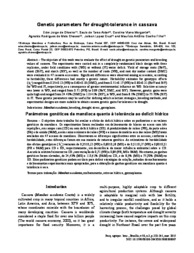Search Publications
Filter by:
| Author(s): FUKUDA, W. M. G.; SANTOS, V. da S. The cassava plant is native to Brazil, where have already been catalogued more than 4000 accessions. This wide genetic diversity has been kept in working collections and in active germplasm banks spre... ... |
| Author(s): SILVA, L. de J. de S.; MENEGHETTI, G. A.; PINHEIRO, J. O. C.; GUIMARAES, R. dos R. Cassava is the main source of energy in the Amazonian diet, hence its social importance. The low productivity and the socioeconomic importance of the crop led Embrapa western Amazon to develop a set o... ... |
| Author(s): VENTURINI, M. T.; ARAÚJO, T. da S.; ABREU, E. F. M.; ANDRADE, E. C. de; SANTOS, V. da S.; SILVA, M. R. da; OLIVEIRA, E. J. de Despite the widespread distribution of the Cassava common mosaic virus (CsCMV) in Brazil, little is known about the losses it causes in yield. The effect of CsCMV on different varieties was evaluated... ... |
| Current status and utilization of the wild cassava germplasm at Embrapa Cassava and Tropical Fruits. Author(s): ALVES, A. A. C.; LEDO, C. A. da S.; COSTA, I. R. S.; MENDES, R.; CARVALHO, P.; SILVA, A. F. Within Manihot gender, with around 98 documented species, only one is the cultivated cassava (M. esculenta Crantz), considered one of the most important staple foods in the human diet in the tropics.... ... |
| |
| Author(s): OLIVEIRA, E. J. de; AIDAR, S. de T.; MORGANTE, C. V.; CHAVES, A. R. de M.; CRUZ, J. L.; COELHO FILHO, M. A. The objective of this work was to evaluate the effect of drought on genetic parameters and breeding values of cassava. The experiments were carried out in a completely randomized block design with thr... ... |
| Author(s): XAVIER, C. A. D.; NOGUEIRA, A. M.; BELLO, V. H.; WATANABE, L. F. M.; BARBOSA, T. M. C.; ALVES JÚNIOR, M.; BARBOSA, L.; BESERRA-JÚNIOR, J. E. A.; BOARI, A. de J.; CALEGARIO, R.; GORAYEB, E. S.; HONORATO JÚNIOR, J.; KOCH, G.; LIMA, G. S. de A.; LOPES, C.; MELLO, R. N. de; PANTOJA, K.; SILVA, F. N.; RAMOS SOBRINHO, R.; SANTANA, E. N.; SILVA, J. W. P. da; KRAUSE-SAKATE, R.; ZERBINI, F. M. Background. The necessity of a competent vector for transmission is a primary ecological factor driving the host range expansion of plant arthropod-borne viruses, with vectors playing an essential rol... ... |
| Author(s): ARAÚJO, F. das C. B. de; CUNHA, E. F. M.; CUNHA, R. L.; FARIAS NETO, J. T. de; SILVA, R. de S. 'Bitter' and 'sweet' cassava are normally distinguished based on the hydrocyanic acid (HCN) content of their roots. Moreover, Brazilian farmers tend to select 'sweet' cassava based on the taste and co... ... |
| Author(s): ANDRADE, L. R. B. de; SOUSA, M. B. e; OLIVEIRA, E. J. de; RESENDE, M. D. V. de; AZEVEDO, C. F. Genomic selection (GS) has been used to optimize genetic gains when phenotypic selection is considered costly and difficult to measure. The objective of this work was to evaluate the efficiency and co... ... |
| Author(s): NORONHA, A. C. da S.; BLANCO, D. G. B.; COSTA, V. A.; SILVA, R. B. Q. da; ARAÚJO, D. G. de; JOHNSON, N. F. The aim of this study was to assess the occurrence and identify the egg-parasitoid species of the cassava hornworm (Erinnyis spp.) in cassava plants (Manihot esculenta Crantz - Euphorbiaceae), facilit... ... |
Observation
Some of Embrapa's publications are published as ePub files. To read them, use or download one of the following free software options to your computer or mobile device. Android: Google Play Books; IOS: iBooks; Windows and Linux: Calibre.
Access other publications
Access the Agricultural Research Database (BDPA) to consult Embrapa's full library collection and records.
Visit Embrapa Bookstore to purchase books and other publications sold by Embrapa.










